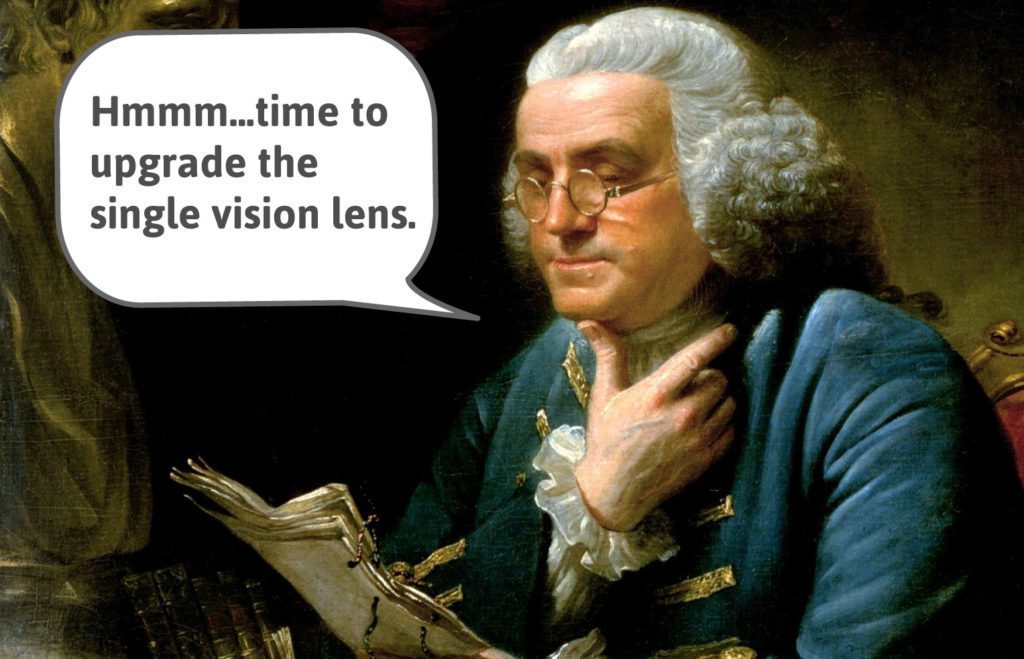
People gush about how wonderful something is—unless it hasn’t worked for them, then they are much more inclined to steer others away from it.
Andrew Beswick, qualified optical dispenser with over 40 years of experience, will give us a rundown on the well-known (and sometimes feared) multifocal lens.
When your optometrist tells you you need multifocal lenses, it’s natural to feel apprehensive. Questions arise: ‘This lens is something different to what I have had before. Why do I need it?’ ‘Will I adapt to it?’ ‘Will I like it?’
The Evolution of the Multifocal Spectacle Lens

The multifocal lens’ roots takes us back to the bifocal lens, first invented by Benjamin Franklin in the 18th century. His invention gave spectacle wearers the ability to see in the distance and read while wearing the same pair of spectacles, benefiting people all around the world. The way he did it, however, was by cutting and gluing two lenses together, which led to the stigma that these were ‘ugly and old’. Manufacturers tried hard to make them less noticeable by inventing the blend bifocal that blends the areas around the reading portion to disguise it—but the stigma still stuck.
This prompted lens manufacturers to start researching new lens designs, which were not only much more cosmetically pleasing, but would also cater for modern-day visual tasks. Therefore they needed to engineer a multipurpose lens that would allow the patient the convenience of seeing distance, intermediate (arms’ length) and reading clearly from a single lens design, hence the term ‘multi’.
With this new lens, though, came the complex problem that multifocal lenses had an area of distortion towards the periphery of the lens what could cause discomfort. But as optical engineers continued to research, they have, like most things, been able to improve dramatically on the initial designs from over 20 years ago—reducing most of the distortions on the edges and resulting in much better vision.
Frequently Asked Questions
What are multifocal lenses?
As their name suggests, multifocal lenses enable the wearer to have multiple prescriptions built into the lens. Mutlifocal lenses are custom-made and allow the wearer to see distance, intermediate and near objects. The lens powers are progressive and seamless, unlike bifocal lenses where a line is visible.

Do I need multifocals?
If the lens you need to correct your near vision is a different strength from the lens you need for distance and you don’t want to carry around two pairs of spectacles, the multifocal lens is ideal.
Can I select any frame when choosing multifocals?
Yes, within reason. Multifocal lenses can be fitted to large and small frames, but there is a size restriction if the frame does not have enough depth. The depth of the frame is important because adequate depth will ensure all areas of the lens perform well. Some sunglass frames also may not be suitable due to the curve of the sunglass lens.
I have heard that multifocals are difficult to get used to. Is this true?
New multifocal designs are always being developed. The new range of digitally enhanced free form lenses provides wider distance, intermediate and near vision. These designs provide ease of adaption and comfort for the wearer. Not all multifocals are the same; there are older designs that may require longer adaption times. My advise would be to choose carefully and ask our optometrist or dispenser to recommend one of the latest digital designs.
How long does it take to get used to multifocal lenses?
We are all individuals and we all have different visual needs. Some patients leave with little to no concerns, some require a few days to adapt. As mentioned previously the better the design, the more ease in adaption.
What makes a good multifocal fit?
A good multifocal fit means the multifocal lens is the correct design and is customised to suit the patient’s visual needs. The frame is adjusted correctly to ensure peak performance of the lens design.
Customisation refers to the patient’s visual needs and how we can improve their vision for the tasks they need to perform.
Things optical dispensers consider:
- Is the patient mainly concerned about reading and would like the convenience of being able to leave the spectacles on for long periods of time?
- Is the patient’s needs more devices related? (e.g., for computer use, iPad or phone, etc.)
- Does the patient require a wide field of distance vision from the multifocal without peripheral distortion?
- Has the patient requested the widest intermediate or near vision available?
- What is the patient’s work environment (e.g., distance from computer, number of screens, etc.)
- How much time is required for the patient to complete their work tasks?
- Does the patient experience eye strain or fatigue?
- Is their previous pair of spectacles suitable for today’s tasks?
Why are some people unable to adapt to multifocal lenses?
Non-adaption can be related to a number of issues:
- Patient disposition—the patient is unwilling to persevere with the concept
- Performance and customisation—the incorrect multifocal design has been selected for the patient’s needs
- Poor facial fitting of the frame at the time of delivery—multifocals need specialised facial fitting to ensure maximum performance
- Poor explanation—when the optical dispenser fails to explain and demonstrate to the patient how the lens will suit their needs
- The dispenser does not reinforce the features and benefits of the multifocal lens design
Are multifocals expensive?
Multifocal lens es are custom-made lenses. They are specifically manufactured to the client’s own prescription. So it is like having that special dress tailored or suit custom made. Multifocal lenses range from $260, but consider their special manufacture and their dynamic design. Multifocal lenses will provide the wearer with comfort and convenience for their busy lives by providing a solution to lifestyle and occupational needs for many years.
es are custom-made lenses. They are specifically manufactured to the client’s own prescription. So it is like having that special dress tailored or suit custom made. Multifocal lenses range from $260, but consider their special manufacture and their dynamic design. Multifocal lenses will provide the wearer with comfort and convenience for their busy lives by providing a solution to lifestyle and occupational needs for many years.
How do I know which multifocal design is right for me?
Our optometrist or dispenser will ask questions in the form of a needs analysis to determine if you would benefit from a multifocal design. They will ask you questions related to your specific needs and suggest the best multifocal design to suit your lifestyle and occupation.

At Eyecare Plus Optometrists providing Eyecare Vision services, we pride ourselves in the fact that we use the latest lens designs available in the market, which means superior lens performance. All our lenses come from well known leading lens manufacturers like Essilor and Nikon, offering multifocal lens designs for all budgets.
For more information on eye health and eye conditions or to find your local Eyecare Plus optometrist, visit: www.eyecarevision.com.au
About Optometrists
Optometrists are experts in vision care who diagnose, manage and treat a wide range of vision problems, eye diseases and ocular conditions. By prescribing spectacles, contact lenses, visual aids and other treatments, optometrists help their patients maximise and retain good vision for life.
